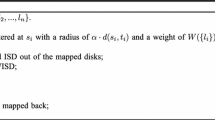Abstract
We present an approximation algorithm for wireless link scheduling under the physical SINR interference model. In the link scheduling problem, it is given a set of \(n\) links in a metric space, each of which is a sender–receiver pair, and the objective is to schedule the links using the minimum amount of time. We focus on a variant of this fundamental problem where the power is fixed, i.e., the power assignment of links is given as part of the input. Specifically, we consider an important category of power assignments called length-monotone sublinear power assignment, which includes the widely studied uniform, mean and linear power assignments. We present a distributed algorithm that can schedule all links in \(O(\log \varDelta (I_{max}+\log ^3n))\) rounds with high probability, where \(\varDelta \) is the ratio between the longest link and the shortest link and \(I_{max}\) is the maximum nearly-equilength class affectance of the link set. It is shown that the proposed algorithm is \(O(\log \varDelta )\) approximate to the optimal schedule in dense networks with \(I_{max}\in \varOmega (\log ^3n)\). To the best of our knowledge, our algorithm is the first distributed one whose approximation ratio is independent of the network size \(n\). Our result also shows that the \(\varOmega (\log n)\) lower bound (Halldórsson and Mitra in: ICALP, 2011) on the approximation ratio does not hold for link sets with \(\log \varDelta \in o(\log n)\).
Similar content being viewed by others
References
Andrews M, Dinitz M (2009) Maximizing capacity in arbitrary wireless networks in the sinr model: complexity and game theory. In: INFOCOM
Ásgeirsson EI, Halldórsson MM, Mitra P (2012) A fully distributed algorithm for throughput performance in wireless networks. In: CISS
Asgeirsson EI, Mitra P (2011) On a game theoretic approach to capacity maximization in wireless networks. In: INFOCOM
Chafekar D, Kumar V, Marathe M, Parthasarathy S, Srinivasan A (2007) Cross-layer latency minimization for wireless networks using SINR constraints. In: Mobihoc
Dinitz M (2010) Distributed algorithms for approximating wireless network capacity. In: INFOCOM
Dubhashi D, Ranjan D (1998) Balls and bins: a study in negative dependence. Random Struct & Algorithms 13(2):99–124
Fanghänel A, Kesselheim T, Räcke H, Vöcking B (2009) Oblivious interference scheduling. In: PODC
Fanghänel A, Kesselheim T, Vöcking B (2011) Improved algorithms for latency minimization in wireless networks. Theoret Comput Sci 412(24):2657–2667
Goussevskaia O, Halldorsson M, Wattenhofer R, Welzl E (2009) Capacity of arbitrary wireless networks. In: INFOCOM
Goussevskaia O, Oswald YA, Wattenhofer R (2007) Complexity in geometric sinr. In: MobiHoc
Halldórsson MM (2012) Wireless scheduling with power control. ACM Trans Algorithms 9(1):71–720
Halldórsson MM, Holzer S, Mitra P, Wattenhofer R (2013) The power of non-uniform wireless power. In: SODA
Halldórsson MM, Mitra P (2011) Nearly optimal bounds for distributed wireless scheduling in the sinr model. In: ICALP
Halldórsson MM, Mitra P (2011) Wireless capacity with oblivious power in general metrics. In: SODA
Halldórsson MM, Wattenhofer R (2009) Wireless communication is in APX. In: ICALP
Kesselheim T (2011) A constant-factor approximation for wireless capacity maximization with power control in the SINR model. In: SODA
Kesselheim T, Vöcking B (2010) Distributed contention resolution in wireless networks. In: DISC
Li H, Wu C, Yu D, Hua Q-S, Lau FCM (2013) Aggregation latency-energy tradeoff in wireless sensor networks with successive interference cancellation. IEEE Trans Parallel Distrib Syst 24(11):2160–2170
Min M, Prokopyev O, Pardalos PM (2006) Optimal solutions to minimum total energy broadcasting problem in wireless ad hoc networks. J Comb Optim 11(1):59–69
Shi Z, Srimani PK (2006) An online distributed gossiping protocol for mobile networks. J Comb Optim 11(1):87–97
Wang Y, Wang Y, Yu D, Yu J, Lau Francis CM (2014) Information exchange with collision detection on multiple channels. J Comb Optim. doi:10.1007/s10878-014-9713-5
Yan Y, Yu D, Wang Y, Yu J, Lau Francis CM (2014) Bounded information dissemination in multi-channel wireless networks. J Comb Optim. doi:10.1007/s10878-014-9804-3
Acknowledgments
This work was supported in part by the National Natural Science Foundation of China Grants 61073174, 61373027 and 61103186, Hong Kong RGC GRF grant 714311, Shu Shengman Special Fund, HKU Small Project 104003571.066237.14200.301.01 and Natural Science Foundation of Shandong Province Grant ZR2012FM023.
Author information
Authors and Affiliations
Corresponding author
Rights and permissions
About this article
Cite this article
Yu, D., Wang, Y., Hua, Q. et al. Distributed wireless link scheduling in the SINR model. J Comb Optim 32, 278–292 (2016). https://doi.org/10.1007/s10878-015-9876-8
Published:
Issue Date:
DOI: https://doi.org/10.1007/s10878-015-9876-8




